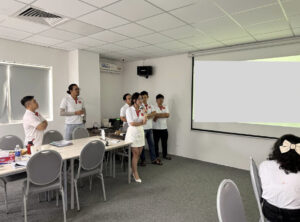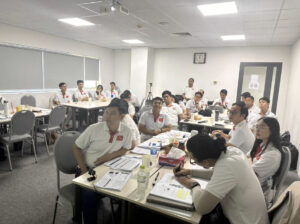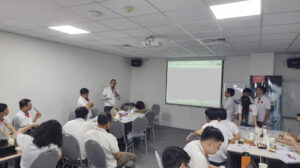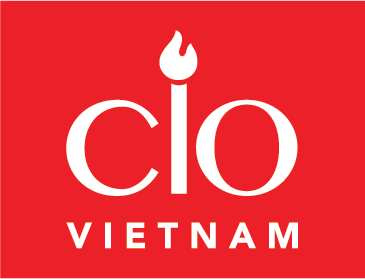Last month, we delved into the first official module of the CIO Coaching program, an experience that proved to be a period of profound professional metamorphosis. It was an immersive journey that significantly expanded my understanding of Digital and IT Strategy. I now feel a sense of clarity, which was previously obscured by the sheer complexity of the subject. This piece will narrate my journey of acquiring this knowledge, expressing my feelings as I navigated the demanding yet rewarding curriculum. I will focus on three pivotal areas for me and my teammates: First, discovering a balanced strategic focus was a revelation. Second, understanding the interplay between implementation approaches and risk became practical knowledge. Third, navigating team dynamics during turbulent phases taught me about true leadership. This program was more than academic; it was a crucible for growth.
Discovering a Balanced Strategic Focus
My initial foray into determining a balanced strategic focus for a company’s digital strategy felt like navigating a dense fog. The program materials, particularly the concepts outlined, emphasized the necessity of balancing various critical aspects. The dual pursuit of customer/market relevance and operational excellence initially seemed like a precarious tightrope walk. I grappled with how an organization could vigorously pursue external market demands, which often requires agility and innovation, while simultaneously maintaining internal operational excellence and sustainability. The documentation cautions against focusing on one to the detriment of the other. The cautionary tale of Kodak, for instance, which overlooked digital photography due to its established film capabilities, served as a stark reminder of this delicate equilibrium.
The program’s coaching sessions were instrumental here. We dissected our business contexts and debated the merits of looking outwards versus inwards. A “Voilà!” moment arrived during a simulation. My team had to devise a strategy for a traditional event organizing company. We initially leaned heavily on radical market-facing innovations, which neglected the underlying operational chaos. The direct feedback from our coach, mirroring the ITIL guiding principles, was that our strategy was unsustainable. True balance, we learned, was not about choosing one path but about weaving them together. This learning reshaped my thinking, moving me from a binary approach to a more holistic, integrated perspective. A feeling of empowerment replaced my initial confusion. I now understood that a robust digital strategy embraces this inherent tension, leveraging it for sustained competitive advantage. This was a clear and impactful result, deeply influencing my design thinking and understanding of strategic formulation.
Understanding Implementation Approaches and Risk
The second significant area of development involved grasping the relationship between digital strategy implementation approaches and their associated risks. Our coaches required us to effectively apply this into our assignments through day-and-night working sessions and presentations. I learned that every implementation choice, whether a large-scale transformation or an incremental one, carries a unique risk profile. These risks are not monolithic; they encompass disruption risks from competitors, innovation risks tied to new ventures, ever-present cybersecurity risks, and engagement risks with stakeholders.
Navigating Team Dynamics and Leadership
Perhaps the most challenging, yet ultimately rewarding, part of the program was navigating the “storming” phase within my team. We were a group of individuals with varied backgrounds and strong opinions. Initial enthusiasm for our project soon gave way to friction through strained communication. Differing viewpoints on strategy and execution led to moments of chaos. I recall feeling a sense of frustration alongside the pressure to deliver high-quality assignments. It was during this turbulent period that the coaching on digital leadership and team dynamics proved invaluable. This module emphasized the importance of a “digital mindset,” including fostering communication and relationship management.
I consciously decided to try and act as an anchor. I focused on practicing active listening during our heated discussions and made an effort to ensure everyone felt heard, even if we didn’t agree. There was no single magic solution; it was just a combination of persistent, small actions. Gradually, we found a rhythm after the storm subsided. We began to leverage our diverse perspectives as a strength rather than a point of conflict. This experience was a powerful lesson in leadership: it was not about having all the answers, but about facilitating an environment where the team could find its own. I felt a significant personal transformation in my teamwork and leadership practices. Guiding the team through chaos to a productive state was one of those marvelous, quiet accomplishments.
Conclusion
In conclusion, this first module has been an intensely transformative experience. It has equipped me with not just theoretical knowledge of Digital and IT Strategy, but also with practical methodologies and a refined leadership approach. My understanding of strategic balance, the nuanced dance between implementation and risk, and the art of navigating team dynamics has matured significantly. The program provided a baseline against which I can measure my future progress in this field. I feel better prepared to contribute meaningfully to any organization’s digital journey. The knowledge gained feels less like a collection of facts and more like an integrated framework for thinking and acting strategically in an increasingly complex BANI world.



Author: Nguyen Minh Tai – SS09
Organization: GFT Technologies Vietnam
Position: APAC Solution Architect
[ABOUT US] – CIO Coaching is a non-profit program that trains digital managers and leaders aspiring to become CIOs (Chief Information Officers) and CTOs (Chief Technology Officers).
– Register for enrollment now: https://ciocoaching.org/tuyen-sinh/
#CIOCoaching
#CIOVietnam
#Hạt_giống_lãnh_đạo_CNTT
